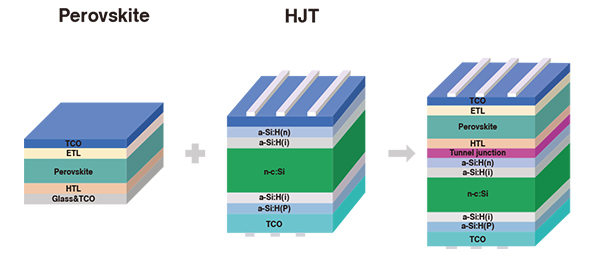In the rapidly evolving field of photovoltaic technology, HJT (Heterojunction) and TOPCon (Tunnel Oxide Passivated Contact) have been the industry’s focal points. However, with the introduction of perovskite materials, HJT combined with perovskite is gaining attention for its unique advantages, becoming a hot topic in the solar industry. This article explores the benefits of HJT combined with perovskite over TOPCon and how this combination is shaping the future of photovoltaic technology.

1. Introduction to HJT Technology
HJT is known for its high photoelectric conversion efficiency and excellent performance in low-light conditions. It forms a heterojunction by stacking an amorphous silicon thin film on a crystalline silicon substrate, reducing surface recombination and enhancing the cell's open-circuit voltage and short-circuit current.
2. Challenges with TOPCon Technology
TOPCon achieves surface passivation by applying an oxide layer and a polycrystalline silicon layer to the cell's surface, reducing recombination losses. However, achieving higher efficiency with TOPCon faces challenges, including complex processes, cost management, and the difficulty of further efficiency improvements.
3. The Role of Perovskite Materials
Perovskite materials are ideal for boosting solar cell efficiency due to their high absorption coefficient, tunable band gap, and solution-processable nature. By combining perovskite with HJT technology, it’s possible to leverage HJT’s high efficiency and further enhance it through the wide-spectrum absorption properties of perovskite.
4. Advantages of HJT Combined with Perovskite
a. Superior Photoelectric Conversion Efficiency: The addition of perovskite significantly expands the spectral response of HJT cells, increasing the number of photo-generated carriers. HJT cells, with a theoretical efficiency limit of 27.5%, already surpass traditional PV technologies. The heterojunction structure, alternating amorphous and crystalline silicon layers, maximizes light absorption, improving energy conversion efficiency.
b. Better Stability: HJT cells not only offer higher efficiency but also superior stability. The HJT-perovskite tandem structure maintains higher efficiency under long-term operation, unlike TOPCon-perovskite, which, despite lower production costs, struggles to match HJT in terms of efficiency.
c. Simplified Manufacturing Process: The solution-processable nature of perovskite materials lowers manufacturing costs, critical for reducing the levelized cost of electricity (LCOE). HJT cells also have a manufacturing advantage, using low-temperature chemical vapor deposition (CVD) to deposit the amorphous silicon layers, followed by transparent conductive oxide (TCO) and p-type or n-type amorphous silicon layers. This simplified process reduces costs and improves yield rates compared to TOPCon’s high-temperature annealing process, which increases production costs and quality variability.
d. Environmentally Friendly Production: Perovskite materials offer a more environmentally friendly manufacturing process as they do not involve toxic or rare elements. Unlike some PV materials that require hazardous elements like lead or cadmium, perovskites are free from such toxins, reducing environmental and health risks. Furthermore, perovskites do not rely on rare elements, whose extraction can harm the environment. Their production consumes less energy, leading to lower carbon emissions.
In conclusion, the combination of HJT and perovskite represents a promising direction for future photovoltaic advancements, with its advantages in efficiency, stability, cost-effectiveness, and environmental sustainability outshining TOPCon in many aspects.







